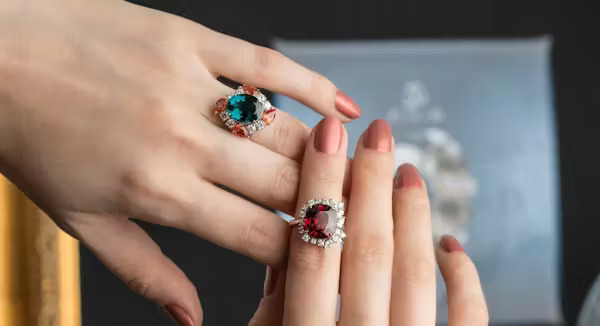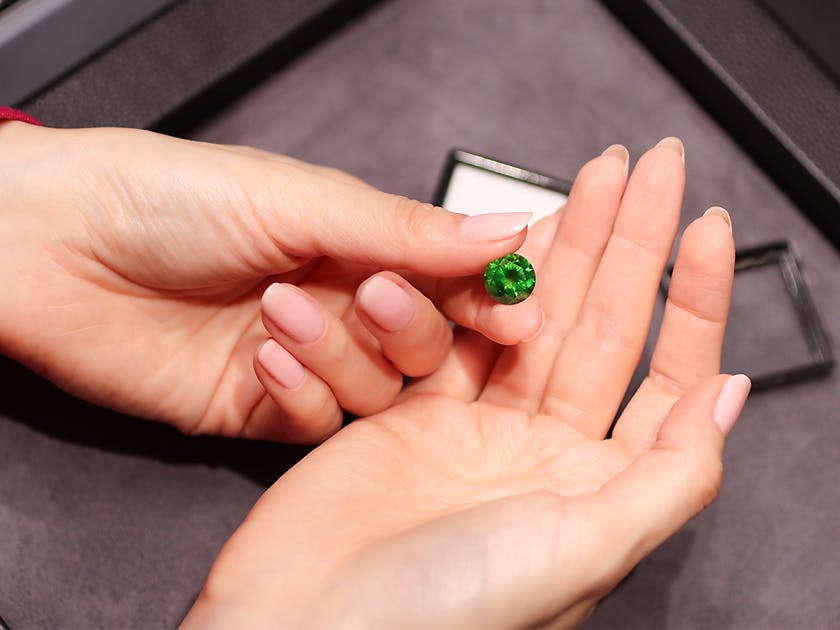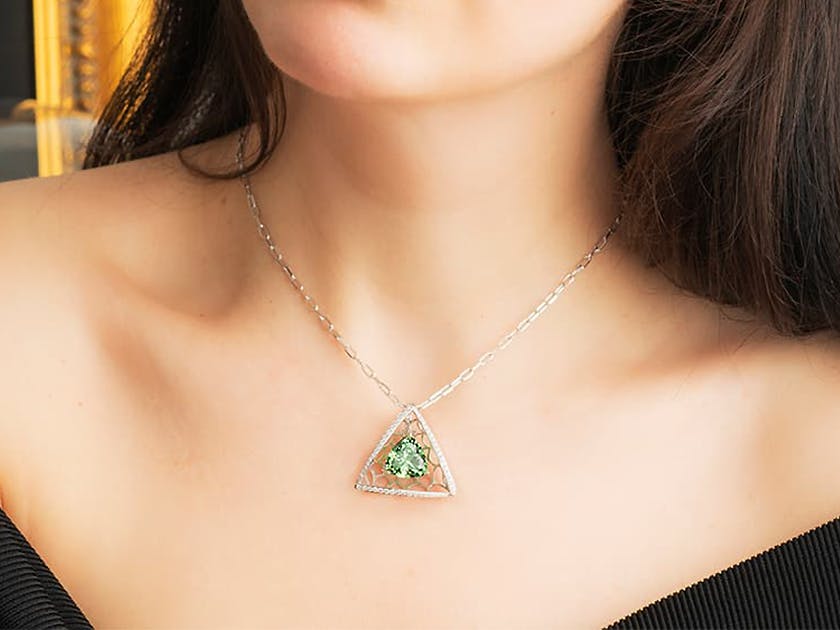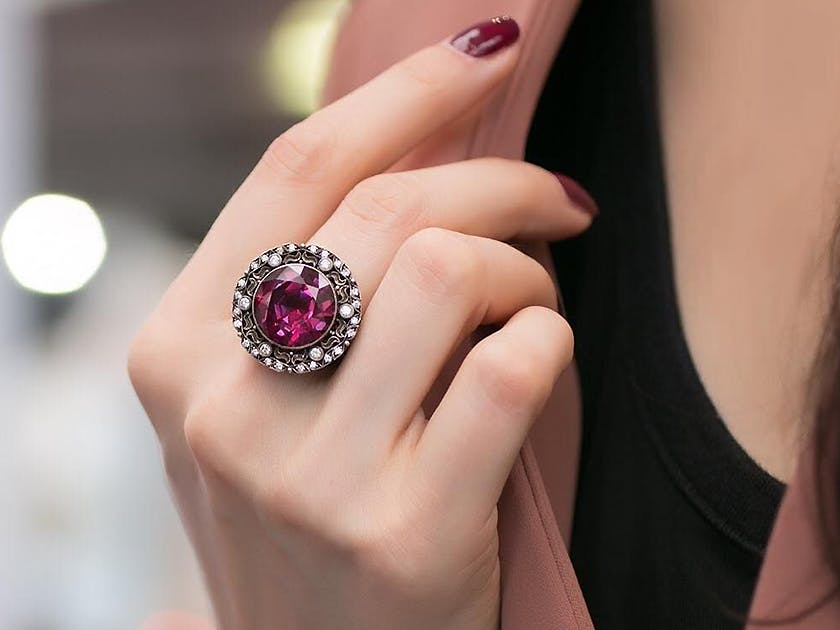
Delve into the world of garnet color, where red is just the beginning. This gemstone guide explores the intriguing palette that garnets display, the elements that give them their distinct hues, and the regions that shape their unique beauty. Without divulging all the secrets upfront, prepare to be enlightened on why garnet’s color is much more than what meets the eye, and what to anticipate as you read further.
- Key Takeaways
- The Palette of Garnet: More Than Just Red
- Garnet’s Rainbow: Understanding Color Variations
- The Geography of Garnet Colors
- Garnet Groups and Species
- Valuing Different Types of Garnet
- Caring for Your Colorful Garnets
- Summary
1KEY TAKEAWAYS
-
Garnets offer a diverse color range beyond the classic red, including rare blues, vibrant greens, and even colorless varieties, influenced by their chemical compositions and trace elements.
-
The colors of garnets are closely tied to their geographical origins, with different regions producing unique hues, such as Africa’s red pyrope and green tsavorite or Asia’s golden hessonite.
-
The value of garnets depends on rarity and color vibrancy, with rare types like demantoid and tsavorite being highly prized, and proper care is essential for maintaining their beauty over time.
2 THE PALETTE OF GARNET: MORE THAN JUST RED

Round-Cut Russian Demantoid Garnet by Katerina Perez
Garnets have long been treasured for their captivating colors, which span a full spectrum that defies the common misconception of a singular red gemstone. From the deep traditional reds to the unexpected blues and even rare colorless forms, garnets present a dazzling array of choices for enthusiasts and collectors alike.
The hues of these gemstones are assessed on the color wheel spectrum, providing a diverse palette for jewelry and ornamentation.
Red Garnet: The Traditional Favorite
The quintessential red garnet, a staple in jewelry, offers a range of shades from the vibrant orange-red to the deeper, wine-like hues of dark red and purplish red. These variations cement the red garnet’s position as a traditional favorite, with its broad spectrum of tones offering something for every admirer of this classic gemstone.
Green Garnet: A Verdant Rarity
Within the green garnet family, tsavorite and demantoid stand out as rare treasures, with the latter’s brilliant green hue and diamond-like dispersion making it particularly sought-after.
These gems, with their vibrant colors and rarity, are a testament to the diversity that the garnet group has to offer, showcasing various garnet varieties.
Uncommon Hues: Blue and Yellow Garnets
The blue green garnet remains a captivating anomaly, changing from a reddish hue in daylight to a purplish or bluish tone under incandescent light, a phenomenon that underscores the complex beauty of these gemstones.
Yellow garnets, bearing sunny shades that range from golden to fiery orange, add yet another layer to the garnet’s colorful personality, just like the rare blue garnets and the stunning color garnet.
3 GARNET’S RAINBOW: UNDERSTANDING COLOR VARIATIONS
The myriad of colors exhibited by garnets is a direct result of their unique chemical compositions and the presence of trace elements that act as color makers. These subtle differences in elements like chromium or vanadium can significantly alter a garnet’s hue, even among stones with identical proportions of their main components.

White gold Ring set with a 19.62-ct Spessartite Garnet by Katerina Perez
Chemical Formula and Crystal Structure
Garnets such as pyrope and grossular are classified as allochromatic, which means their color is derived from impurities within their crystal structure. In their purest form, these gemstones would be colorless.
Trace Elements: The Color Makers
Elements responsible for the wide array of colors found in pyrope garnets include:
-
Chromium and vanadium, which can create pinks, rare blues, and greens
-
Manganese, which lends an orange or yellow tint to garnets rich in spessartine
-
Iron, which can provide a purplish-red hue in varieties abundant in almandine.
4 THE GEOGRAPHY OF GARNET COLORS
The fascinating colors of garnets are not only a result of their chemical makeup but also of their geographical origins, with different regions producing distinct hues and varieties. Among the main garnet producing countries, India, China, and Australia lead in garnet production, each contributing unique colors to the global palette from industrial-use almandine to the rare iridescent andradite found in Mexico.
African Riches: Vibrant Reds and Greens
Africa is particularly renowned for its vibrant red pyrope garnets and the highly prized green tsavorite, a type of grossular garnet valued for its vivid color and rarity.
Asia’s Cinnamon Stones: Hessonite Garnet
Asia, and especially Sri Lanka, is famous for producing hessonite garnet, a variety that is cherished for its distinctive golden and cinnamon hues, further illustrating the geographic influence on garnet colors. This unique variety is also known as cinnamon stone.
5 GARNET GROUPS AND SPECIES
Garnets are classified into six main types based on their chemical composition, which plays a crucial role in the colors they exhibit. The fascinating interplay between idiochromatic and allochromatic elements within garnet species like almandine and grossular contributes to the broad color spectrum that garnets are known for.
Pyrope and Almandine: The Red Gems
The red gemstones of the garnet family, including pyrope garnet and almandine, showcase a variety of hues from deep reds to reddish brown and violet-reds, primarily influenced by the iron content in their composition. Among these, almandine garnet is a popular choice for jewelry enthusiasts.
Grossular Garnets: From Orange to Green
Grossular garnets, including the coveted green tsavorite and the warm hessonite, exhibit a vast range of colors due to the presence of trace elements like vanadium, chromium, manganese, and iron in their metamorphic rocks formation environment.

Grossular Garnet pendant with diamonds in white gold by Katerina Perez
6 VALUING DIFFERENT TYPES OF GARNET
The value of garnets is closely tied to their rarity and the vibrancy of their colors, with rare hues like peach or colorless commanding higher prices in the market.
Price Influencers: Color and Clarity
Factors such as color saturation and the presence of inclusions play a significant role in determining the value of garnets, with clear, vibrant stones being more sought after and thus more valuable.
Collectors’ Delight: The Allure of Rare Garnets
Rare garnets like demantoid and tsavorite are particularly attractive to collectors for their beauty and scarcity, making larger stones of these varieties exceptionally valuable.
7 CARING FOR YOUR COLORFUL GARNETS
Garnets, with proper care and maintenance, can retain their beauty and luster for generations. Regular cleaning using non-abrasive cleaners and careful storage can help maintain the gemstone’s vivid colors and prevent damage.
Cleaning and Storage
To ensure the longevity of garnet jewelry, it should be cleaned gently and stored in a way that prevents scratches, especially from harder stones.
Handling and Wear
When wearing or handling garnets, it’s crucial to protect them from scratches and impacts, considering their relative hardness and potential inclusions that could weaken the stone.

Gorgeous garnet ring with diamonds by Yaroslav Argentov
8 SUMMARY
Having journeyed through the vibrant world of garnets, we’ve discovered the vast spectrum of colors that these gemstones exhibit, influenced by their complex chemical compositions and geographical origins. We’ve delved into the historical significance of garnets, their modern applications, and the factors that contribute to their value. With the knowledge of how to care for these precious stones, we can ensure their enduring brilliance for generations to come.
